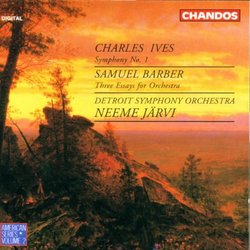| All Artists: Ives, Barber, Jarvi, Detroit Symphony Orchestra Title: Symphony 1 / 3 Essays for Orchestra Members Wishing: 0 Total Copies: 0 Label: Chandos Original Release Date: 1/1/2000 Re-Release Date: 10/28/1992 Genre: Classical Styles: Historical Periods, Modern, 20th, & 21st Century, Symphonies Number of Discs: 1 SwapaCD Credits: 1 UPC: 095115905326 |
Search - Ives, Barber, Jarvi :: Symphony 1 / 3 Essays for Orchestra
 | Ives, Barber, Jarvi Symphony 1 / 3 Essays for Orchestra Genre: Classical
|
Larger Image |
CD Details |
CD ReviewsA very enjoyable recording. One of my favorites! 02/23/1999 (5 out of 5 stars) "If you have never heard Ives' 1st Symphony, you are in for a pleasant surprise. It is a lyrical, expressive work that is wonderfully performed on this disc. Jarvi and the D.S.O. make a great team. The 3 "Essays" by Barber are perhaps more familiar works to most listeners, and they are also well performed here. But the Ives Symphony is the highlight." A Great Performance and a Great Introduction to Ives's Music James Skrydlak | Pella, Iowa | 07/05/2000 (5 out of 5 stars) "Charles Ives is not the first composer who comes to mind when one thinks about child prodigies. His First Symphony, however, composed while he was a student at Yale, ranks with those of Dvorak, Brahms, and Tchaikovsky, as among the greatest of the late nineteenth century. Ives moved more and more out of music's mainstream as he got older. This is definitely the most conventional of his symphonies, and, as such, a good introduction to his music.This performance is one of amazing transparency and clarity; all the voices are heard. My first classical recording, bought in 1969, was a set of the Ives Symphonies, including Ormandy's recording of the First, now unfortunately out of print. This performance by Jarvi and the Detroit Symphony lacks some of the vigor and drive of the one on my old LP, particularly in the final movement, but it brings out counterpoint that I had never noticed before.The performances of Barber's Essays for Orchestra are fine, as well. The Ives Symphony, though, is truly something special - both the work itself and the performance here." Conservative Ives; Resplendent Barber Moldyoldie | Motown, USA | 01/07/2009 (4 out of 5 stars) "I know a different Charles Ives, the early twentieth century musical iconoclast who so dauntlessly took American music "where no one had gone before". The Ives found here is a fine enough student composer from Yale who was apparently hamstrung by his conservatively predisposed professors. That said, his turn-of-the-century Symphony No. 1 as performed here is an enjoyable Late Romantic work in four movements that won't necessarily shake the wax out of one's ears, but still makes for a well-constructed, tuneful, and sometimes dramatic listen. The first movement commences with a soft, lilting waltz and develops in typical sonata form, finally building to a crescendo and ending dramatically. The elegiac second movement is especially redolent of Dvorák's "New World" with its beautiful and mournful main theme introduced on the cor anglais and echoed on the strings -- Järvi and the Detroiters milk the movement for as much languor as propriety allows. Elsewhere, the symphony mostly takes us along for an enjoyable, if not especially challenging jaunt through what was apparently the musical sensibilities of late 1890s American musical academia -- Ives' professors must've been proud. Unfortunately, the spacious acoustic and low-level recording lends itself more to background listening as opposed to divining orchestral detail, which would probably have made for a more involving performance -- turn up the volume!
The Three Essays for Orchestra of Samuel Barber are interesting, often moving shorter works thoroughly evocative of Middle America; they're not always heard together. Here, they're given a mostly similar soft-edged treatment as the Ives, yet performed with great commitment toward a pastoral view of Barber's conception. In No. 1 and No. 2, we become soaked up in wipe open landscapes and echoing themes; dramatic crescendos elevate us to a musically exultant stratosphere -- the percussion are especially impressive here! No. 3 takes on a different flavor, at least initially, as it's framed in a more modernist vein, but eventually becomes steeped in a tonal resplendency with percussive echoes. The orchestra paints a soft portrait filled with beautiful sweep and color, then eventually lets loose in a wonderfully dramatic accelerando that brings it all home. The vivid spaciousness of the recording serves this music very well!" |

 Track Listings (7) - Disc #1
Track Listings (7) - Disc #1